Manchester City Academy Training in Istria with Three Premier League Stars
July 23, 2022 - The Manchester City Academy is training in Istria for the sixth consecutive year, but this time including three Premier League champions.
For the sixth year already, the academy of the English giant arrives in Novigrad in Istria for preparations. Young Istrian footballers had the privilege of playing with them and taking selfies, reports Gol.hr.
The U-18 and U-23 teams of the Premier League champions arrived in Istria for a nine-day training session, and with them are three first-team players - Phil Foden, John Stones, and Ilkay Gundogan.
Due to strict COVID restrictions, the star trio could not go to the preparations in the United States with the first team, so Pep Guardiola sent them to Istria to prepare with the young players.
Gol.hr writes that despite all efforts, getting a short statement from one of the most expensive footballers today, Phil Foden, is practically impossible. The English club's PR team had done an excellent job hiding him.
"He is very humble, full of respect, works hard every day," City's academy director Jack Wilcox said of the England international team player and added:
"He wants to improve every minute of every day, and that is why, according to many, he is the best young player in the world."
The talented young City players, some of whom have already made a few appearances for the first team, really admire Croatian footballers, especially Luka Modrić, Ivan Rakitić, and Mateo Kovačić.
Although City can bring today's best players, they invest considerable money in their football academy.
"Any team in the Premier League can buy top talent from around the world, not just Manchester City, but the academy is much more than that. It tries to develop players who live in the local community and inspire them," said Wilcox.
To follow the latest sports news in Croatia, follow TCN's dedicated page.
5 Things To Do in Istria in November
Istria is alive and vibrant all year round, and there's no shortage of events outside of the tourist season. We bring you a few suggestions on what to see and do if you're planning to visit Istria in November
1. Warm up with a walk - and some wine - in Novigrad
Technically, it’s still October, but the forecast calls for a sunny weekend in Istria, and so... A nice long walk with gorgeous vistas, coupled with a few nibbles and glasses of wine - sounds like a great way to usher in the new month, right? The popular event Wine & Walk by the Sea will see its 4th instalment this Saturday in Novigrad.
The scenic 10km route will first take you through vineyards and olive groves, and then along the coast, providing a splendid view of the Novigrad city centre. Winemakers and restaurateurs from the area will be showcasing their specialties at six tasting stops along the way, plus a surprise stop halfway through.
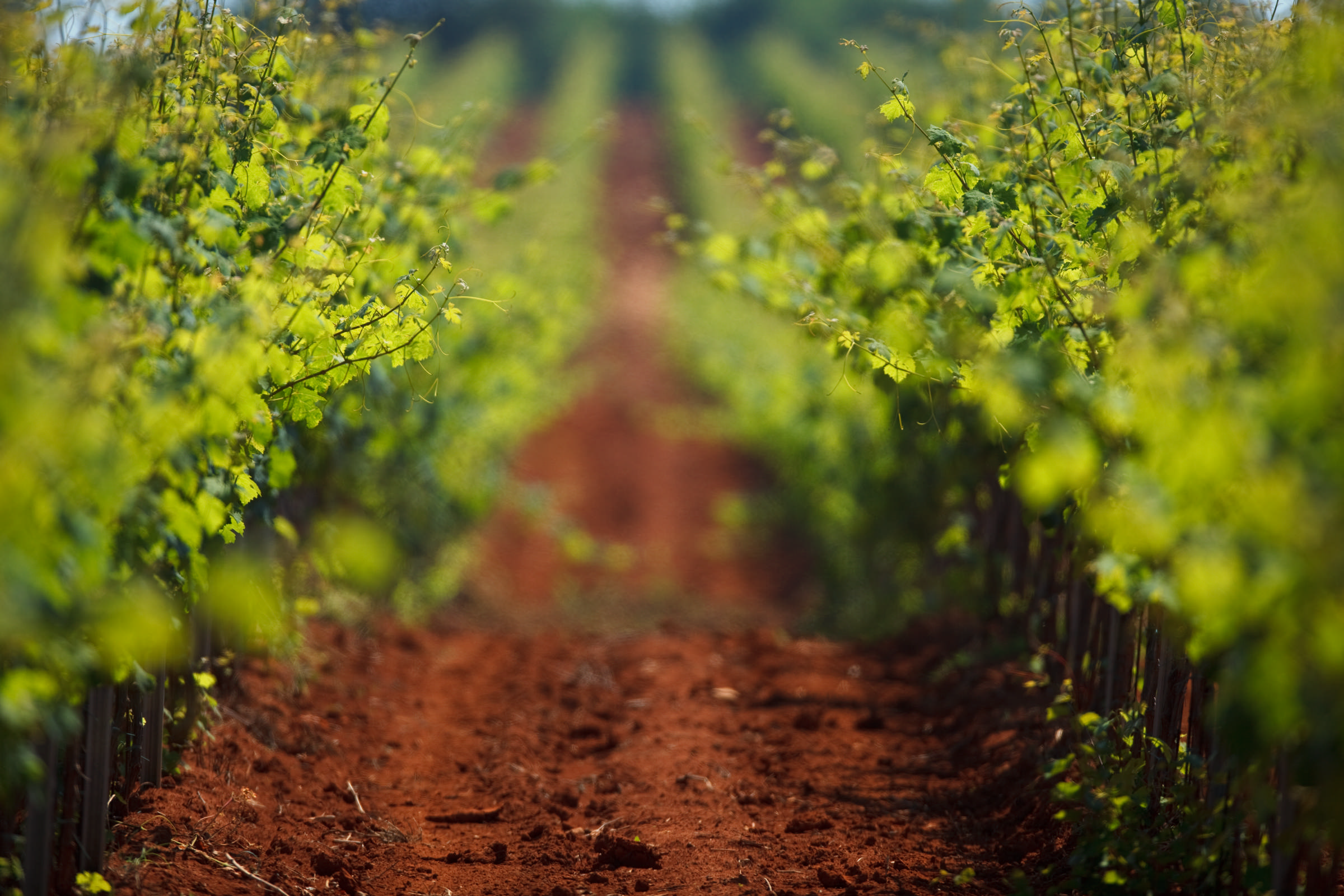
© Romulic & Stojcic
Gourmet delicacies will be presented by local caterers Sergio, Kod Marice, La Taverna, Half 8 and Konoba Nino, with dessert provided by Ošo bakery. Each stop has a wine pairing, courtesy of winemakers Moreno Ivančić, Stancija Fava, Leonardo Palčić, Ghira, Vino P&P – Pervino, and Vina Demark.
The walk begins in the morning at Kastanija beach where participants can register and collect their tasting glass together with a map of the trail. Departures are scheduled every 20 minutes.
When: Saturday, October 30th. Registration 8.30 AM - 12PM
Where: Kastanija beach (start and finish), 3km north of Novigrad
Note: attendance is only possible with a Covid certificate or a negative rapid antigen test result no older than 48 hours. Tickets, pricing and the full schedule available at Colours of Istria.
2. Go out on the town in Pula
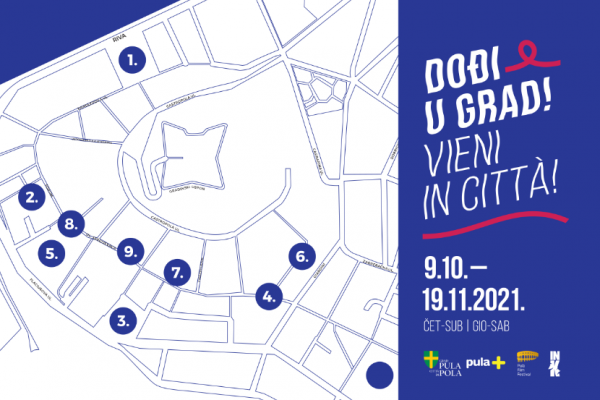
Image source: Dođi u grad - Vieni in città
Well... It's more like, Come to town!, but you sure can amp it up and paint the town red. Jokes aside, the city center in Pula is turning into a massive venue for a plethora of fun activities and events over the next few weekends. Live music, stand-up shows, food & wine, art, film screenings, sports, workshops and many other things await visitors from Thursday to Saturday each week in November.
When: Oct. 28-30, Nov. 4-6, 11-13, 18-19
Where: several locations in Pula, see map
You can find a detailed program for each weekend here (in English) and look out for individual events on Facebook.
3. Visit the Book Fair(y) in Pula
The book fairy’s coming to town for the second time in 2021! After the belated 2020 edition that took place earlier this year, the beloved literary event is returning to Pula for its regular annual instalment in the second half of November.
The Book Fair(y) in Pula traditionally features more than 300 publishers from Croatia and the region, and is visited by over 60,000 lovers of literature each year. The fair’s program is always built around a central theme, and this time around, it’s Love: during the ten-day event, panels and discussions will be questioning whether the timeless phenomenon still makes the world go round.
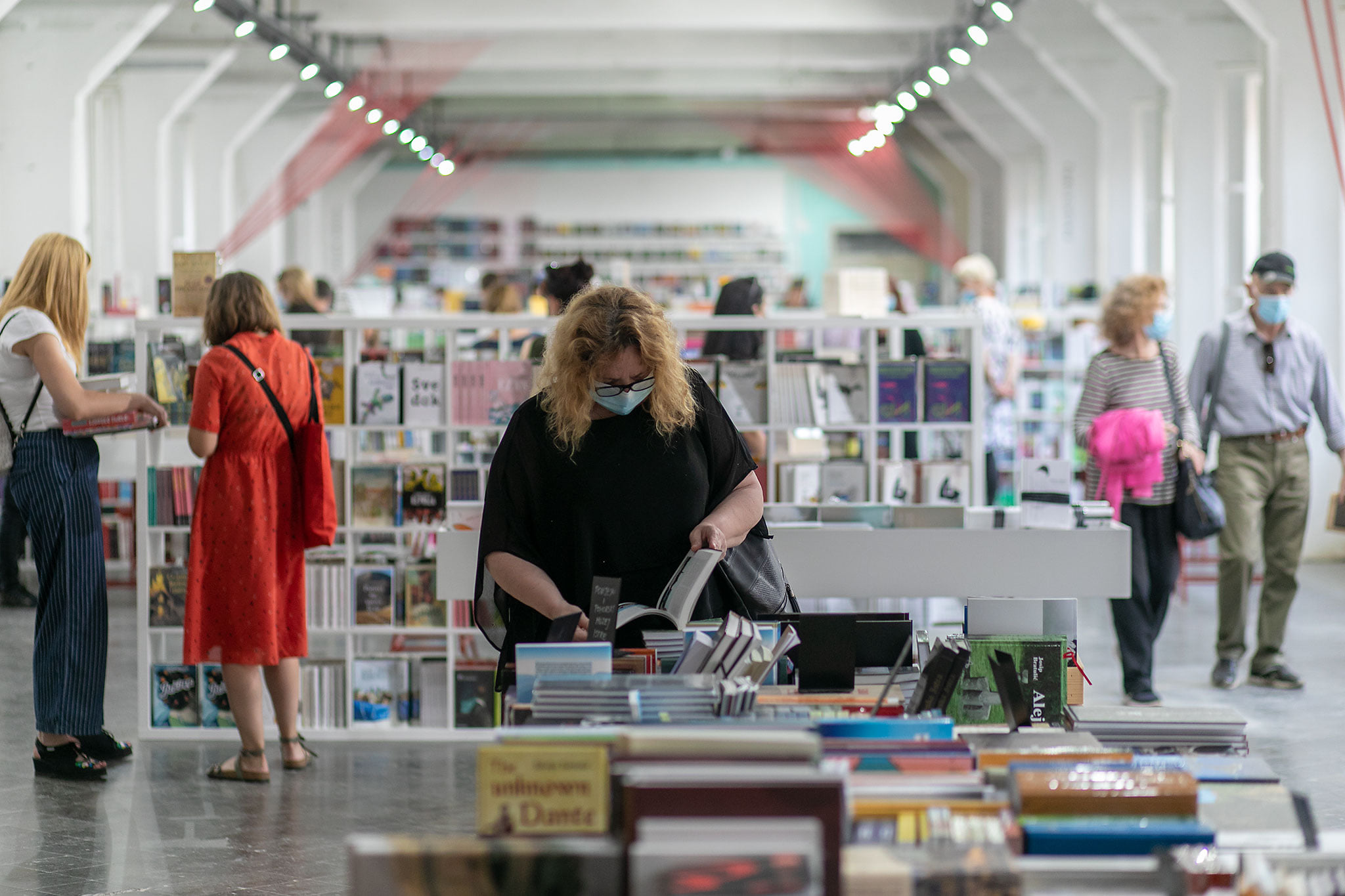
Image source: Sanjam knjige
This year, the book fair in Pula breaks its decades-long tradition by changing venues from the Austro-Hungarian palace of Marine-Kasino to the former textile factory Arena Trikotaža. Part of the program will also take place at The Shipyard Pub, located on the same street. Numerous Croatian and international writers will be attending the ten-day event, so make sure to check out the full program once it's released. If you're not up for panels and the like, you can simply enjoy strolling around the fair and buy a good book or two.
When: November 19th - 28th
Where: ex. Arena Trikotaža / The Shipyard Pub - St Theodor Passage 1, Pula
More info to be announced on the official website (in English) and Facebook page.
4. Explore the flavours of autumn in Brtonigla
Colder months call for hearty meals, and as the temperatures continue to drop, we could all use a nice bowl of pumpkin soup.

Image source: Ruth Georgiev / Unsplash
Luckily, with autumn in full swing, food markets in Istria are bursting with the best seasonal produce the region has to offer. Mushrooms, truffles, pumpkin, chestnuts, quince and pomegranate are on the menu in several restaurants participating in the Flavours of Autumn, a month-long gourmet event in Brtonigla.
Food & Wine Primizia and konobas Astarea, Morgan and Silvano prepared menus featuring delicious filling dishes inspired by the autumn season, paired with Istrian wines and olive oils, and available at promotional prices. Check out the menus here ... and don’t wait too long to book a table.
When: Oct 15 - Nov. 21
Where: Brtonigla
5. ...and keep exploring all flavours of Istria at the Open Days of Agritourism
You didn’t think this list would only have one gourmet item? We’re in Istria, after all - so even if you don’t get a chance to visit Brtonigla in November, culinary temptations await all over the region.
The Open Days of Agritourism will take place over four weekends in November, with twelve agricultural estates participating in the 11th annual instalment of the popular manifestation. Family-run farms will be offering menus based on their own produce and paired with other locally sourced delicacies. It's a truly authentic experience of traditional Istrian cuisine: grown, raised, harvested, prepared, cooked, baked and served by the hard-working hosts.
Most agricultural estates in Istria also offer accommodation, and there’s plenty to do for a weekend. Kids will enjoy meeting cute farm animals, there are various hiking and cycling trails for the whole family to explore, and after a long day out, there’s always a delicious full plate to get back to.
When: November 6-7, 13-14, 20-21, 27-28
Where: Agricultural estates Cerovac, Dušani, Giovanna Allegra, Montižel, Ograde, Pineta, Sia, Stara Štala, Štefanić, Ondina, Pod Čripnjom, Stancija Buršić
Booking in advance is recommended. More info available here (Croatian only, more details to follow).
People Also Ask Google: How to Get to Istria, Croatia in 2021?
February 17, 2021 – In Google's "People also ask" feature, the hard questions are the ones that start with "how." It is not always easy to find answers how to do something or how to get somewhere. However, in this article, we will try to explain how to get to Istria, the biggest and famous Croatian peninsula.
Located in the most western part of Croatia, Istria is a peninsula known for its rich cultural heritage, as well as it's delicious gastro offer that includes world's best wine, olive oil, and truffles. Last year, Istria was named world's best olive oil region for the sixth consecutive year, which is one more reason why Istria is an unavoidable place to visit when in Croatia.

Sources: Istria.hr, Pexels, Romulić and Stojčić
We will let you explore the charms of Istria for yourself, but first, we will try to help you how to get to Istria.
How to get to Istria Croatia by car?
Istria is one of the best, if not the best traffic-connected Croatian coastal region. Thanks to its geographical position, it achieves a record number of tourist arrivals and overnight stays every year, and the cities of Poreč and Rovinj are at the very top of Croatian tourist destinations.
The largest number of tourists come to Istria by land, by personal vehicles, from the close countries of Germany, Austria, and Italy. If you're coming to Istria from those countries, or from that direction, you must pass through Slovenia.
There are four main border crossings with Croatia and Slovenia in Istria. The first ones are Plovanija and Dragonja/Kaštel, from the direction of Koper, marked in red on the photo below.

Screenshot Google Maps
The road to Plovanija goes along the Slovenian shore, and the border crossing Dragonja/Kaštel is on the road E751. After the Croatian border, that road connects with the most famous and most important road in Istria – the so-called Istrian Y, a Y-shaped highway, which connects all parts of Istria.
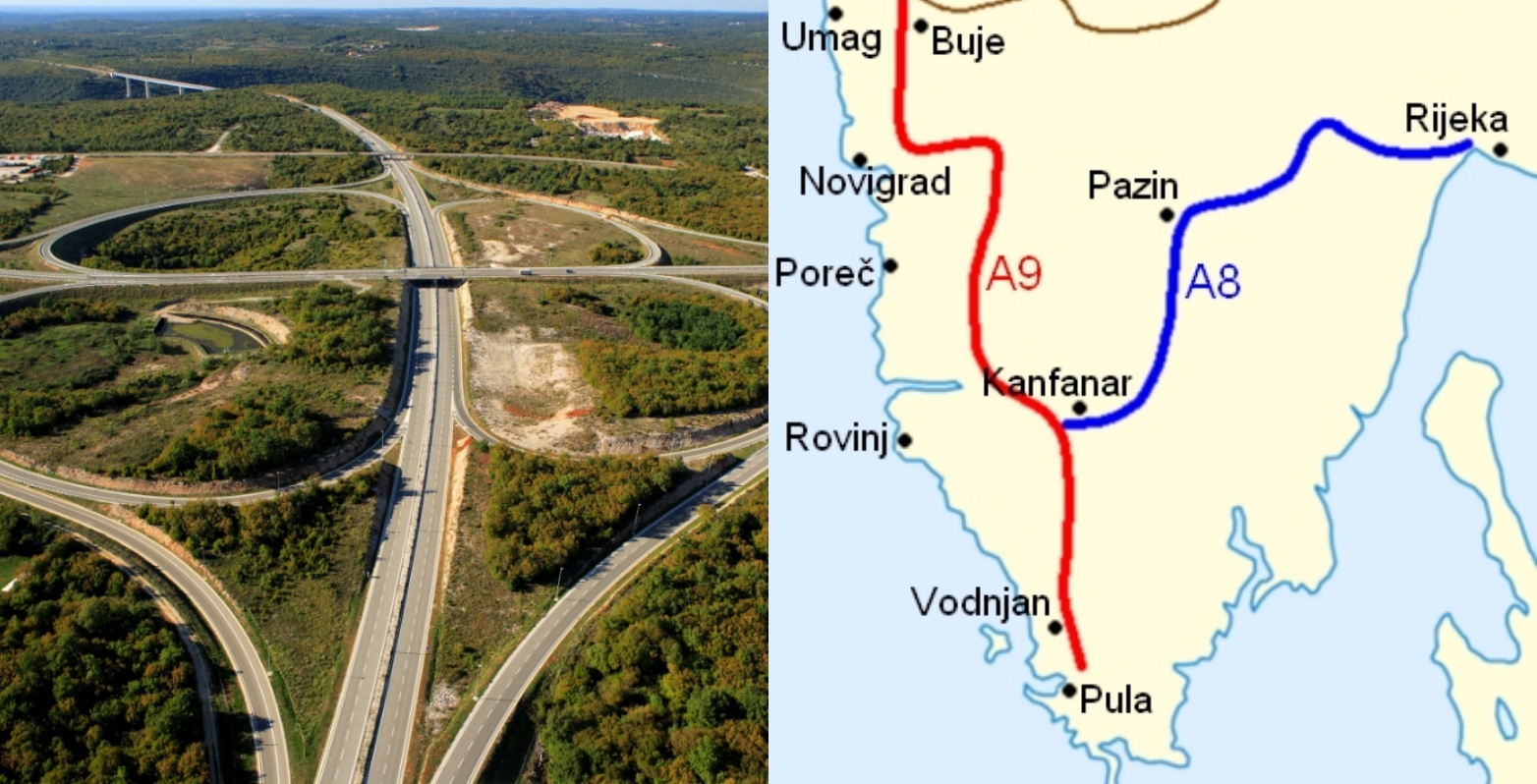
On the left: Center of Istrian Y in Kanfanar (Romulić and Stojčić) / On the right: the map of Istrian Y (Wikipedia)
That part of the Istrian Y, marked in red on the photo below, goes along the western shore, and it is a highway A9 from the Slovenian border to Pula. It connects Istrian cities of Umag, Novigrad, Poreč, Rovinj, and Pula. However, the highway itself is a little away from these cities, so you will have to turn to state roads to reach them.
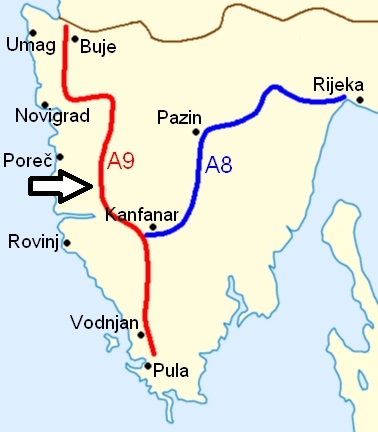
A9 highway, a part of Istrian Y, marked in red / Wikipedia
The second two important - and also the busiest - border crossings in Istria are Pasjak and Rupa, marked in blue on the first photo. Although they are located in the Primorje-Gorski Kotar County, they are a gate to Istria County.
As shown on the photo below, the highway E61 goes to Croatia via the Pasjak crossing border from the direction of Trieste in Italy. If coming from the direction of Ljubljana, you must cross the Rupa crossing border. Highway E61 (in Croatian: highway A7) from both Pasjak and Rupa end in Matulji (marked in red) near Rijeka, where it connects with the second part of Istrian Y – highway A8 that goes to Kanfanar, the center point of Istrian Y.
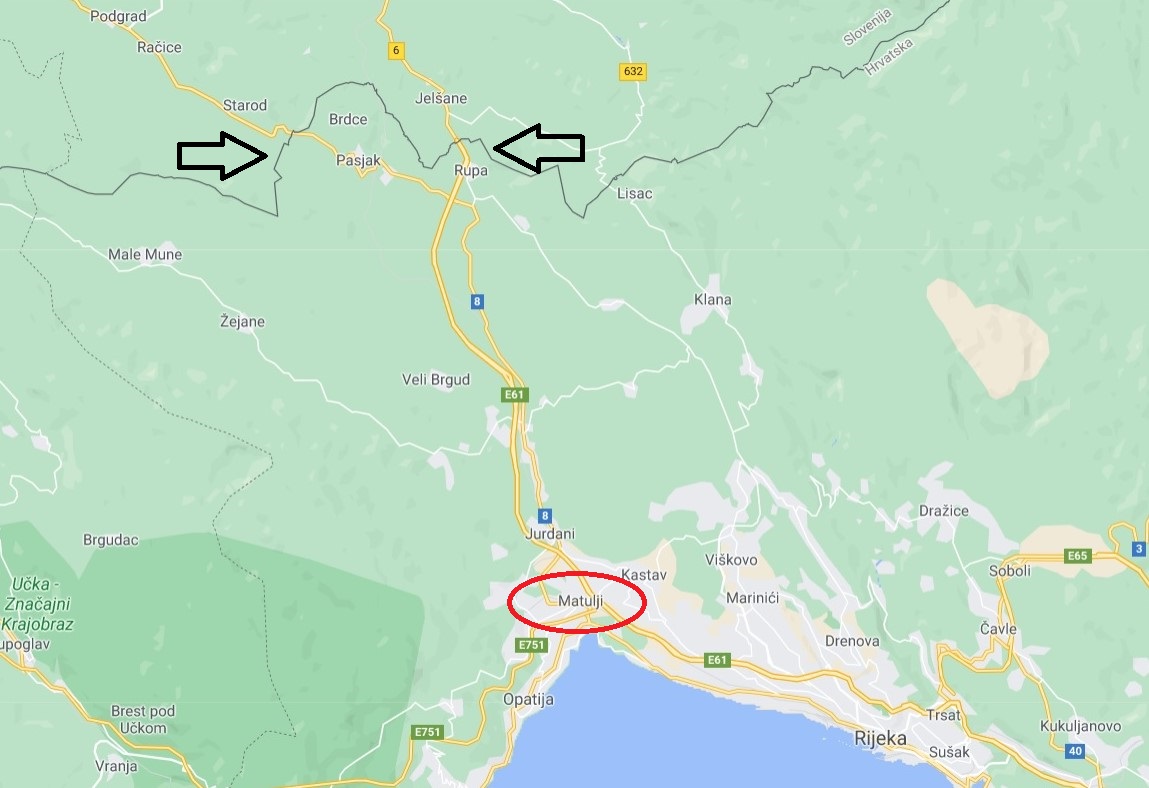
Screenshot Google Maps
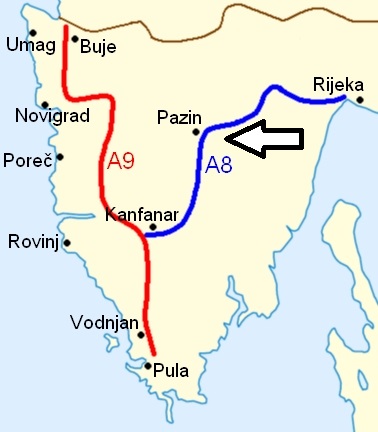
A8 highway, a another part of Istrian Y, marked in blue / Wikipedia
Remember, once you reach Istrian Y, you can reach any part of Istria. Istrian Y is actually a system of two highways, A8 and A9 – learn more about the Istrian Y.
Other Slovenian-Croatian border crossings are Bregana near Zagreb and Macelj near Krapina, from where you can go to Istria via highways E59 and E65.
How to get to Istria by plane?
The only airport in Istria is the one in Pula, while the other close airports are in Friuli Venezia Giulia Airport in Trieste, Marco Polo Airport in Venice, and Treviso Airport in Italy, Jože Pučnik Airport in Ljubljana in Slovenia (also known as Brnik Airport or Fraport Slovenia), Zagreb Franjo Tuđman Airport and Rijeka Airport in Croatia.
Pula Airport welcomes both charter and scheduled flights. Before many flights were canceled due the pandemic, Pula Airport had a solid tourist traffic. One of the most popular airline in Pula was Ryanair, offering cheap flights to some of the biggest European cities. However, the traffic in Pula Airport dropped by 89.6 percent in 2020, compared to the record 2019.
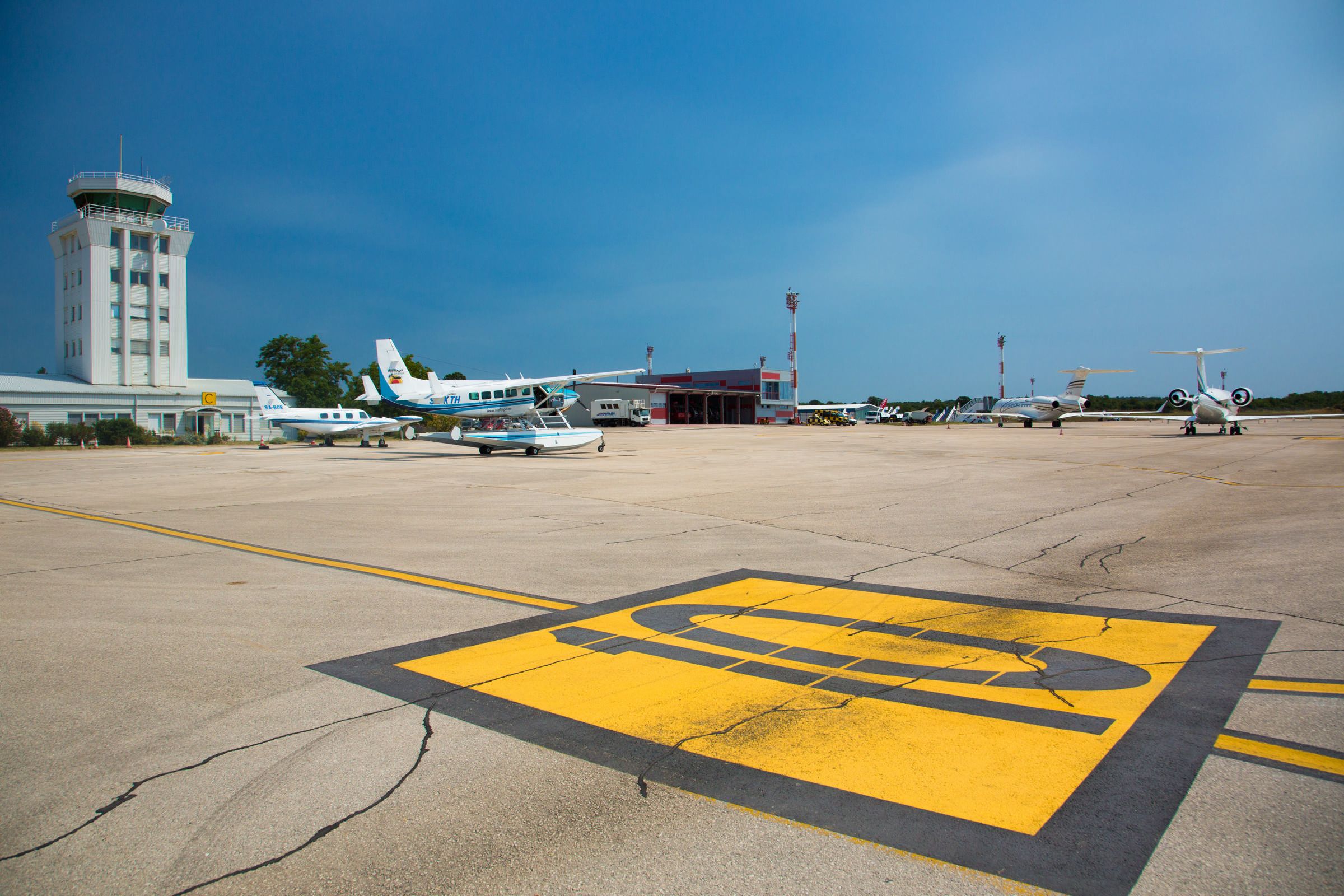
Pula Airport by Romulić and Stojčić
Airlines operating to Pula Airport in 2021 are Air Serbia, British Airways, Croatia Airlines, EasyJet, Eurowings, Finnair, Jet2.com, Lufthansa, Norwegian, Ryanair, S7 Airlines, TUI, Volotea, and Wizzair.
In 2021, it will be possible to come to Pula, Istria by flights from Belgium, Croatia, Denmark, Finland, France, Germany, Ireland, the Netherlands, Norway, Russia, Scotland, Serbia, Sweden, Switzerland, Ukraine, and the UK.
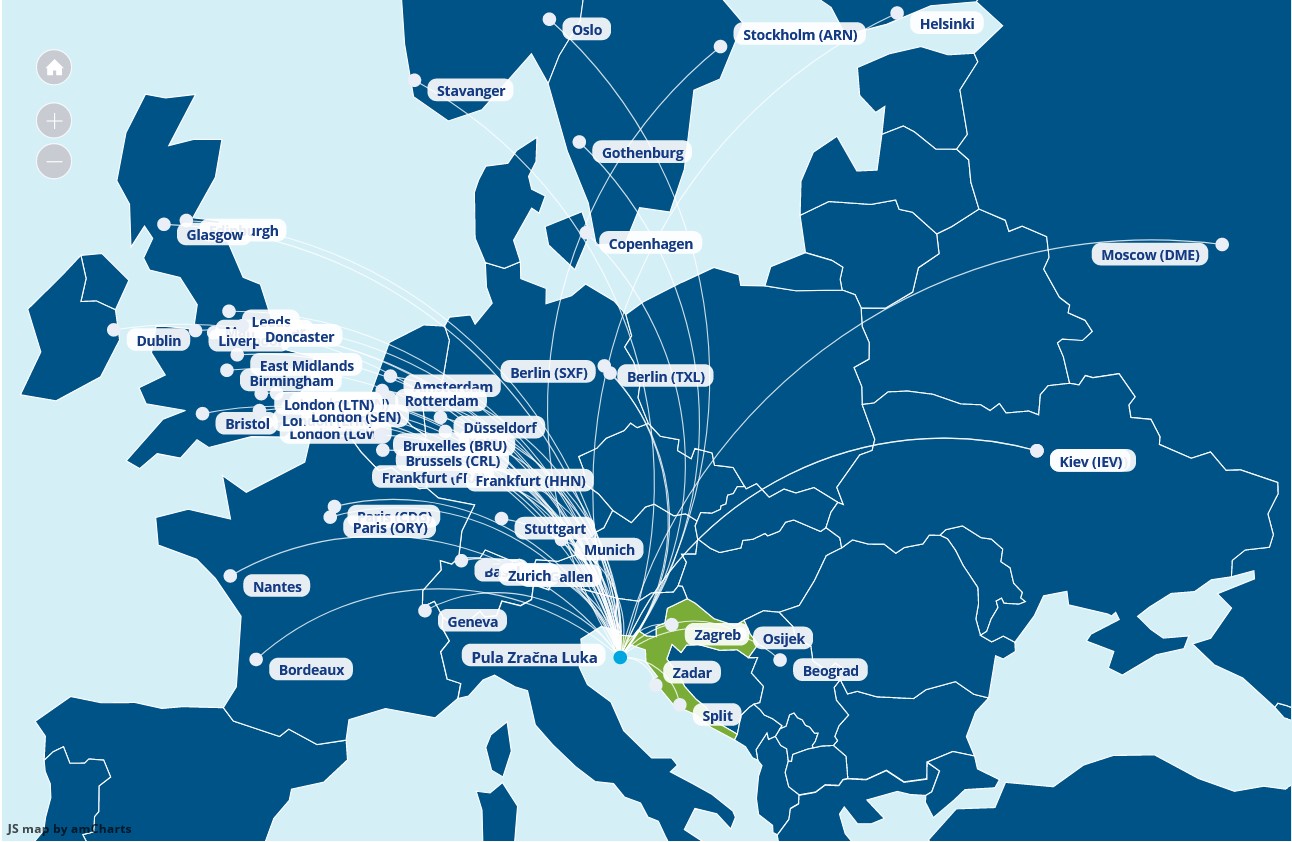
Screenshot Pula Airport
Follow TCN's dedicated page for the newest information about flights to Croatia.
How to get to Istria by bus?
If you come from neighboring countries, the bus may be a good option to get to Istria. Since northern and western Croatia is well-connected with northern Italy, you can get to Istria by bus from Trieste to Buje, Poreč, Rovinj, Pula, along with other places on the way. The bus from Trieste to the western part of Istria, as well as to Rijeka, operates throughout the year.
There are also bus lines from Venice to Pula by the Pula-based bus company FILS, operating the whole year. Another Pula-based bus company Brioni Pula provides bus services from Padova (with stops in Venice and Trieste) to Vodnjan, Rovinj, Buje, and Pula. All the bus lines from Italy to Croatia can be found here (in Croatian).
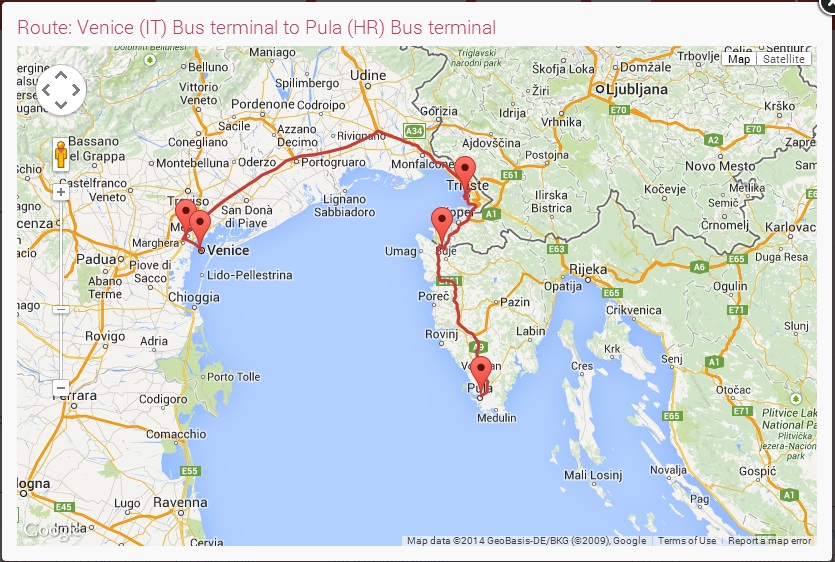
Bus routes from Venice, Italy to Pula, Croatia / Buscroatia.com
Istrian bus companies Brioni Pula i FILS also provide bus lines from many Croatian cities, mostly from the capital of Zagreb. If you're coming from continental Croatia, Istria is the closest seaside region to visit. There are many bus lines, especially during summer. You can find them also on the Flixbus and Arriva bus companies' webpages.
How to get to Istria by ferry?
Since Croatia has a sea border with Italy, one way to get to Istria from Italy is ferry. There are two ferry providers from Italy to Istria – Adriatic Lines and Venezia Lines.
Adriatic Lines operates from Venice to Istrian cities of Pula, Rovinj, Poreč, and Umag. Catamaran lines from port San Basilio in Venice to Istrian cities last about two and half hours. One-way ticket price is 65 euros (or 500 kunas) for adults and 32.50 euros (250 kunas) for children. The schedule for 2021 is still unavailable.
Adriatic Lines' catamarans are quite famous, as they are recognizable in Istrian ports. "Prince of Venice," mostly seen in Poreč port, has an attractive and distinctive design, while "Adriatic Jet" is known for its speed and interesting appearance.
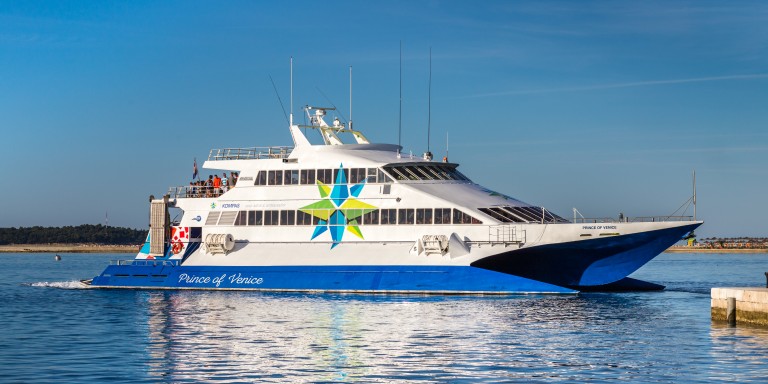
Prince of Venice in Poreč port / Adriatic Lines
During summer, namely from April to October, Venezia Lines have catamaran lines from Venice to Piran, Poreč, Pula, Rovinj, and Umag. Ticket prices range from 59 to 69 euros per person (450 to 520 kunas per person). It takes about three hours and 15-30 minutes to get in one direction, depending on the route. However, the schedule for 2021 has not yet been published.
Ferries from Istria to Italy also allow the transport of pets and bikes.
To find more ferries from Italy to Croatia, check the Istrian Sun webpage.
How to get to Istria by train?
If you decide to come to Istria by train, you can arrive very quickly using the lines from Ljubljana or Zagreb.
The line from Ljubljana can take you to Buzet or Pula every day and it takes four hours. There are no more trains going from Italy to Croatia.
If traveling from the Croatian capital, there are no direct train lines to Istria. However, you can take the train to Rijeka, but then travel by bus from Rijeka to Lupoglav, from where you can continue your train journey through Istria, to Pazin and Pula. The whole journey take four hours. You can book the train tickets on the Croatian Railways webpage.
Six railway stations in Istria are in Pula, Kanfanar (mentioned above as the center of Istrian Y), Vodnjan, Pazin, Buzet, and Lupoglav. Pula and Pazin are the main railway stations in Istria, from where you can quicky come to western Istrian cities of Poreč, Rovinj, and Novigrad.
Fun fact about travelling by train in Istria?
Did you know that Istria is home to the only island on the Adriatic coast connected by train? Its name is Uljanik and is one of the six islands in the Pula bay.
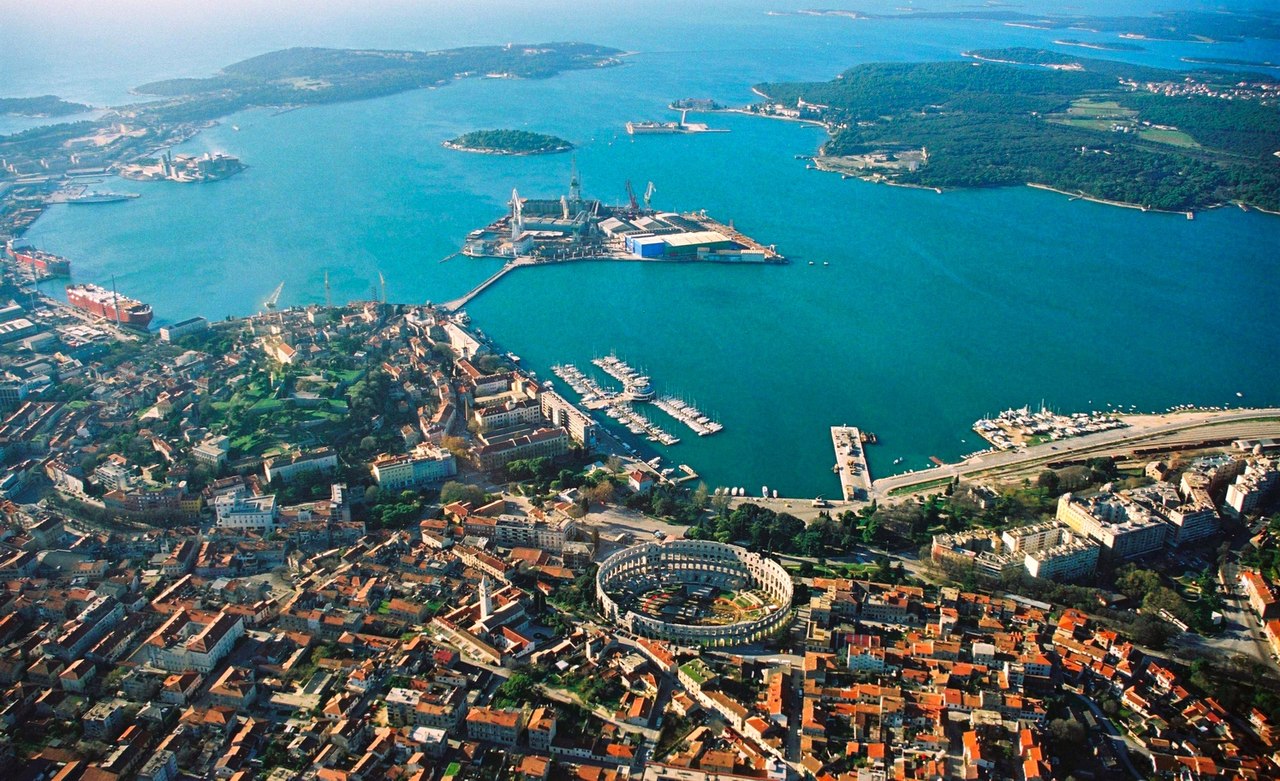
Pula and Uljanik island seen from above / Wikipedia
The name Uljanik, after which the nearby Pula shipyard was also named, comes from olive trees or, in Croatian, "ulike" that grew on it. Of all the olive trees, only one remained in the center of the island, surrounded by the Uljanik shipyard facilities, whose central plants are located on the island.
Interestingly, the industrial track for the shipyard Uljanik that goes from Pula railway station continues over the bridge, all over to the island of Uljanik. The bridge thus connects the island of Uljanik with the coast, making Uljanik the only Croatian island connected to the mainland by rail.
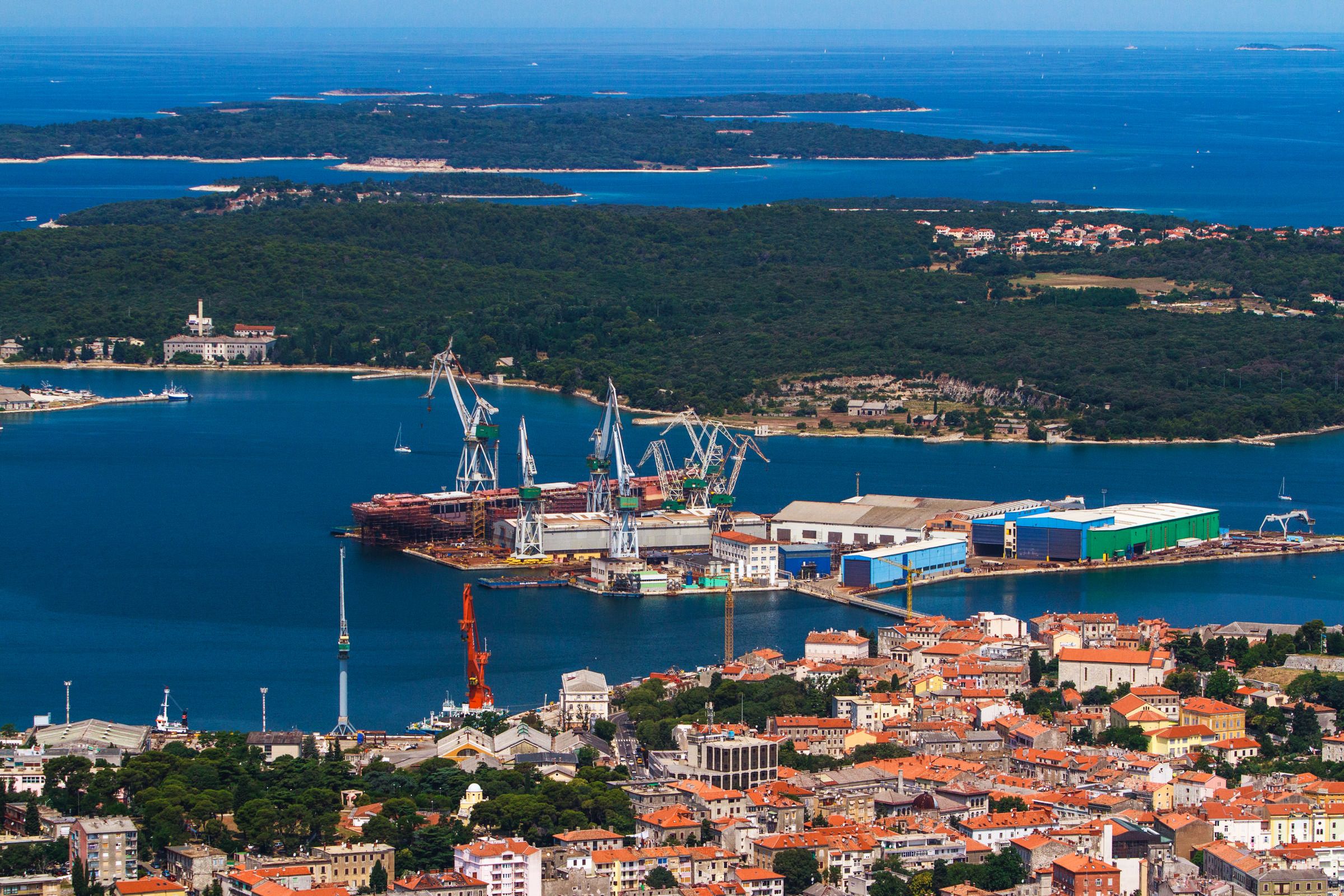
Uljanik shipyard's main plants on the island of Uljanik / Copyright Romulić and Stojčić
To follow the People Also Ask Google about Croatia series, click here.
Novigrad-based Aminess Expanding Business on Island of Krk
As Poslovni Dnevnik writes on the 1st of October, 2020, the Novigrad-based Aminess, a well known and successful Croatian tourist company, has expanded its business to Njivice hotels and a camping resort on the beautiful island of Krk, which start operating under the Novigrad-based Aminess brand on October the 1st, 2020.
Aminess Magal Hotel (formerly Hotel Beli Kamik), Aminess Veya Hotel (formerly Hotel Jadran), Aminess Gaia Green Villas (formerly Marbera Flora Green Villas) and Aminess Atea Camping Resort (formerly Camp Njivice) are new members of the Novigrad-based Aminess portfolio, which will jointly contribute to the company's additional growth and strong development in the competitive Croatian tourism sector.
"We're extremely pleased that the Njivice resort and camp have become part of the Aminess family and we will now have the opportunity to create great results together and contribute to the further development of Njivice and the island of Krk. We believe that the synergy of these two companies, Aminess and Hotel Njivice, will be a great success and mean stronger market visibility. We're convinced that we will further strengthen the fantastic story we have been creating with our employees and the guests in Novigrad, Orebic and on the island of Korcula for years with our new colleagues in Njivice on the island of Krk,'' said Zrinka Bokulic, President of Laguna Novigrad, which owns the Aminess brand.
The Novigrad-based Aminess already has a very rich portfolio, boasting the hotels Aminess Maestral 4 * and Aminess Laguna 3 *, the camps Aminess Sirena 4 * and Aminess Maravea Camping Resort 4 * located in Novigrad, while hotel Aminess Lume 4 * is located on Korcula, and Aminess Grand Azur 4 * is located on the picturesque Peljesac peninsula.
For the latest travel info, bookmark our main travel info article, which is updated daily.
Read the Croatian Travel Update in your language - now available in 24 languages
Archaeological Remains of Oldest Liburnian Port Discovered in Novigrad Sea near Posedarje
June 7, 2020 - Mato Ilkić and Mate Parica from the Department of Archeology at the University of Zadar recently discovered a much older port in the western part of the Novigrad Sea, 22 kilometers northeast of Zadar.
Zadarski List writes that numerous ports from the Roman Empire have long been located and partly explored on the northern Dalmatian Coast. They are distributed along the main maritime route of the time, which, among other things, includes navigation on the Vir Sea, Zadar and Pašman Channels. But Mato Ilkić and Mate Parica from the Department of Archeology at the University of Zadar recently discovered a much older port.
It is located on a hitherto unknown route that was very navigable in the period before the Roman conquests. The archeological remains of this port lay in the western part of the Novigrad Sea, opposite Posedarje, 22 kilometers northeast of Zadar. It was built by the Liburnians, and, for now, it is their only port for which the exact location is known.
"Examining aerial photographs, we noticed that along the west coast of the Novigrad Sea not far from Posedarje, and directly next to the huge prehistoric hillfort Budim, there are some dark rectilinear outlines. We went there to dive and on the seabed, we immediately spotted a structure pointing to an ancient harbor whose archaeological remains are approximately 3 meters deep. For now, it is the oldest port in Liburnia, and perhaps in the entire Croatian part of the Adriatic. This is evidenced by the radiocarbon analysis of wood from the port structure, a sample of which we sent to Miami for testing. We recently got a result from Florida that made us quite happy, because it indicates an older time than we had assumed. Namely, the so-called C 14 date indicates that the port was built between 371 and 199 BC. Thus, it belongs to the period of the late classical phase and early Hellenism," Ilkić reveals.
The port is quite large and is not layered with later interventions. It is built partly of large stone blocks and wooden beams. This very demanding and complex construction undertaking at the time could only be carried out by the well-organized and economically very powerful Liburnian community, which was obviously oriented towards maritime and trade, directly or indirectly with very remote overseas regions. This included North Africa, that is, Carthage, Numidia, and Hellenistic Egypt, from which a great deal of money reached Liburnia through Japodia.
For now, it cannot be argued how the Liburnians and Japodes were enriched, but it is possible to reconstruct the sea routes and land routes that ended up in their hands. The topography of the finds of numerous and diverse numismatic materials originating from very distant monetary centers suggests that merchant ships sailed into Liburnian waters near Molat. From that island, a route led to the Vir Sea and the Velebit Channel and further through Novsko ždrilo to the Novigrad Sea, where the newly discovered and for now the only Liburnian port from the period before the Roman conquests is located.
The Liburnians developed a trade network that included the Trans-Velebit hinterland. Namely, after the money reached the southern Liburnian coast by sea, its further land flow can be followed even easier. They found their way in the direction of southern Velebit, where they descended to Lika along its edge and over mountain passes. Here the traffic branched off into two main directions. The northern one led towards the Una river basin and deeper inland towards southwestern Pannonia. The second traffic route is directed to the northwest and led to the pre-Alpine area. But this trade, in which the Japodes also profited, would not have been possible if the Liburnians had not turned to seafaring, as is now witnessed by their spacious port next to the huge fort of Budim near Posedarje.
It is an extremely important and complex archeological site, which is indicated by the finds of very early amphorae, Liburnian pottery, but also those painted that originated in Italy. In fact, the port near Buda sheds a whole new light on the maritime role of Liburnia.
Archaeologists from the Department of Archeology at the University of Zadar have just begun researching this unique northern Dalmatian underwater site from the pre-Roman period, thanks to donated money from Alan Mandić from Turanj and logistical support from the Municipality of Posedarje. Their goal, for now, is to get to know the only Liburnian port, and perhaps the oldest on the Croatian coast, as well as possible, and document and protect it for future generations. The money invested in the research would be returned many times over, because by presenting fascinating and valuable archeological remains of the ancient port of Liburnia, the tourist offer could be enriched.
To read more about lifestyle in Croatia, follow TCN's dedicated page.
New Novigrad: Little Pearl of Adriatic Turns to Gourmet Tourism
February 15, 2020 - Vesna Ferenac, director of the Novigrad Tourist Board, emphasizes that their ultimate goal is more efficient promotion, that is, visibility of the destination and raising the quality of the offer in the city.
"Last year we achieved record results: three percent increase in arrivals and a two percent increase in overnights, exceeding 1.3 million overnights. This is a great result considering that the beginning of the preseason did not start well due to terrible and cold weather. The period before and after the season is very important for us, so this year we are focused on activities during this period to increase the number of guests,” said Vesna Ferenac, director of the Novigrad Tourist Board, speaking about the preparations for the new tourist season.
Glas Istre writes that behind the scenes, they are preparing for the reception and provision of even better service and hospitality of the guests. And as Novigrad, colloquially called the "little pearl of the Adriatic", is becoming an excellent place for an increasing number of tourists.
“We continue with activities related to defining the tourist offer of Novigrad that started in 2018, one of the priority goals of which is branding the destination of Novigrad, according to the guidelines of a document we presented in May last year. So last year, we realized some of the activities that have emerged from this document, such as the summer entertainment program, with which we are continuing with some new content that will fill the week-long program in the city at several checkpoints," Ferenac says.
Based on these guidelines and a printed document, they collected offers to brand the destination and selected designer Marko Baus & associates from a Zagreb agency. For the realization of this vital branding project, they continued to hold workshops with stakeholders of tourism and other offers in the town, i.e., caterers, owners of accommodation facilities, travel agencies, institutions, associations and institutions that organize and conduct various events, but this time, the topic defined the strategic position of the brand for profiling future tourism products and creating experiences for guests staying in Novigrad.
“We also used the latest tools for analyzing guest posts on social networks, analyzing data collected from platforms for reviewing accommodation and analyzing posts on news portals, that is, a digital media image survey of Novigrad was carried out, with about 120,000 posts. By analyzing these announcements through platforms and social networks, we will have a clearer landmark for branding the destination. A pervasive analysis has been made because we believe that guest feedback is essential, as they see and perceive us as a destination, in order to address some of the shortcomings and targeted development. To us, from the perspective of a local, some of the appearances and things in the town may seem different than it would for guests, because we are here every day, and therefore their wishes should be heard and self-critical changes and improvements can be made,” explains Ferenac.
As she points out further, in this project, it was very important to take into account the local observations that were analyzed at the workshops. The result of the work in last year's workshops will compare with the opinions of the guests and define the attributes of Novigrad that need to be more actively promoted and branded to become even more visible in the highly competitive tourism market. Ferenac explains that this complex research and strategic document for destination branding implies a change of the city's visuals, its implementation (unification), that is, connecting all carriers in all fields of the city's tourism offer.
“The ultimate goal is more efficient promotion, i.e., visibility of the destination and raising the quality of the offer in the city. Also, with unique content networking, guests should be additionally stimulated to visit and stay, and spend more throughout the year,” Ferenac points out.
In addition, a number of events have been expanded as the Tourist Board moves ahead with new tourism products.
“We have judged that there is a lack of content related to marine activities. So, in cooperation with an Austrian swim club, we are organizing an international swimming marathon on May 16 and according to the announcements so far, we expect between 200 and 300 swimmers. We will organize a new sailing regatta, but we are still in negotiations,” announced Ferenac and added that they are thinking about new gourmet products.
Namely, for the development of gourmet products, two editions of the new Park Food Fest gourmet event are planned this year, in the pre and postseason, while the traditional gourmet events united under the name Gnam-gnam fest will be realized this year at the Novigrad Captains Evening at the beginning June, and Sardelafest in early September.
“In mid-July, at the increasingly popular event "Che gusto", numerous local and foreign producers of wine, craft beer and food products will present their offer. Also, we continue with events that started last year, like: "Movie nights" with screenings of films in the park under the stars, "Jazz Corner" at Bosko Petrovic Passage, tribute band concerts at the Piazza Grande in Novigrad, "Kids' day” with a program of street entertainers, then music programs on every corner, and debut music nights in the romantic setting of the restored Belvedere Lodge.
There will also be traditional events such as the Painting Ex tempore Contest, Magical Novigrad, Slovenian nights and all sorts of surprises, Ferenac says, adding that every guest is equally good and that there is something for everyone.
To read more about travel in Croatia, follow TCN's dedicated page.
Aminess Sirena in Novigrad Wins Prestigious ADAC Superplatz 2020 Award
As Novac writes on the 11th of January, 2020, the German autoclub ADAC awarded Novigrad's Aminess Sirena Camp the prestigious ADAC Superplatz 2020 designation/award at a recent gala event held in the popular German city of Stuttgart, placing Aminess Sirena on the list which includes some of the absolute best European campsites.
These awards are the highest quality camping awards given annually to the best campsites across Europe. The importance of the ADAC Superplatz award is also borne by the fact that ADAC is the largest German and European automobile club, boasting more than eighteen million members.
''We are extremely proud of the recognition of the ADAC Superplatz 2020, because it's a confirmation that we provide our guests with the best service and superior experience, which is our guiding principle in doing business. This special recognition also acts as a motivation in our efforts to continue investing in improving our facilities and services to make stays here with us even better,'' said Antonia Belavic, Aminess Sirena's camp director.
Thanks to its four stars, the Aminess Sirena campsite near beautiful Novigrad is one of the most regulated campsites in all of Istria. It offers everything a modern family needs for an enjoyable holiday, and is surrounded by pine trees and peaceful bays, making it an ideal destination for all guests who like to relax in nature and also take trips to more urban areas.
In addition to the Aminess Sirena campsite, the winner of the distinguished recognition of the German Auto Club since last year is the Aminess Maravea camping resort, which has also strongly confirmed its quality and exceptionally strong position among the best camps across Europe with the ADAC Superplatz 2019 label.
The high level of quality was further confirmed with awards for being the best large campsite, as well as the Campsite of the Year award given at the Days of Croatian Tourism (Dani hrvatskog turizma).
Make sure to follow our dedicated travel page for much more.
Novigrad Welcomes Croatia's First State-of-the-Art Oil Mill, Nothing Like it Within 500 km
October 17, 2019 - The Al Torcio oil mill in Novigrad, owned by olive grower Karmin Beletic, welcomed the first state-of-the-art olive oil mill in Croatia.
Glas Istre caught up with Beletic, who explained the technology and all its benefits. For example, how the cooling system allows 30 percent more polyphenols to remain in the oil.
“There is no such modernized oil mill within 500 kilometers, or even in parts of northern Italy, so I am flattered that the first state-of-the-art mill was opened in Istria, known as the best olive oil region in the world,” said Beletic.
The newest technology on the market today comes from DMF Pieralisi. The mixers of their Molinova ORO series, in combination with the mill, cools the olive paste during production, thus, making it one of the most modern machines in the world.
Namely, when grinding the olives, their temperature in the mill is further increased by another four to five degrees due to the friction of the particles, which negatively affects the quality and preservation of the oil values. Thus, the cooling system enables temperature control and allows the olive paste to be cooled.
“Another exception to this oil mill is that it uses DMF technology - the Leopard 5 decanter, with a processing capacity of two tonnes per hour, that is, a multiphase decanter, which means that it is done in several stages. Previous machines worked in two or three phases, and each of these processes had its advantages and disadvantages. This processing method combines all the best of both phases mentioned above,” said Beletic.
The great novelty is also that no water is added to the process itself, so the polyphenols contained in the olive paste are not melted in water. Thus, up to 30 percent more polyphenols in the oil are retained in this way.
At the same time, the problem of disposing of the later formed olive vegetation water, which is a high burden for each oil mill, is also solved.
“Another special feature is our certificate for organic production. Namely, the oil mill has four mixers of 800 liters each, in which four batches of oil from four different manufacturers can be processed, which allows us to wash the system between processing. Thus, there are no remnants from previous producers, which gives everyone their own and pure organic oil,” Beletic concluded.
You can see photos of the new oil mill in Novigrad here.
To read more about lifestyle in Croatia, follow TCN's dedicated page.
Aminess Paying Employees 500 Kuna Bonus for Successful Tourist Season So Far
August 16, 2019 - Aminess Hotels & Campsites will pay its employees a bonus of 500 kuna for successfully completing the first part of the tourist season, reports Goran Rihelj of HRTurizam.
The bonus, which will be paid in August with the July paycheck, will be awarded to all employees hired by July 15, 2019, including part-time and full-time employees, and students.
The Aminess hotels and camps in Novigrad, Orebić, and Korčula, employ 650 people in the peak season.
“The company has one of the highest payroll bases for tourism, and with incentives and benefits increasing year after year, accommodation, and hot meals, we are continuously investing in improving the conditions of all employees and offer numerous career advancement opportunities. Regardless of their employment status, everyone is provided with a wide range of training and advanced training programs, such as communication and team leadership skills, foreign languages and presentation and IT skills,” Aminess points out.
Aminess also launched the Aminess Gourmet Lab project this year, which, under the leadership of Chef David Skoko, aims to educate young chefs, waiters, bartenders and other members of the Aminess gourmet team. Also, with the aim of improving work and relationships with guests within the company, the Aminesss Idea project has been launched, which gives employees the opportunity to express their opinions and give their suggestions in order to achieve even better results together. Employees with the best ideas for their contribution earn a cash prize.
In order to provide even better quality accommodation to employees coming from other parts of Croatia and the region, the company has started constructing the first hotel for employees in Novigrad, which will spread over 2,500 square meters.
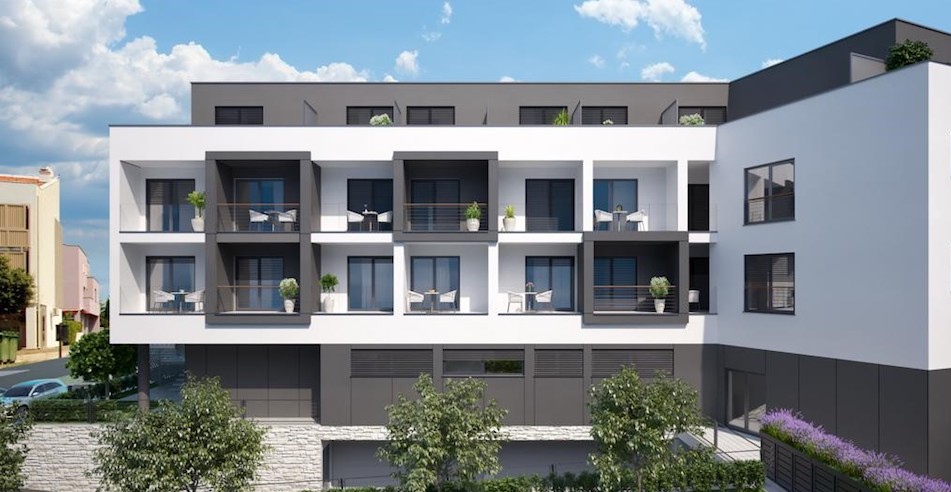
Aminess
The hotel will have a reception, a shared kitchen with a dining area, parking, and an enclosed bicycle storage room, while most of the rooms will have double beds with a private bathroom, French balcony or terrace, modern furniture and a TV, as well as a heating and cooling system. In addition to free Wi-Fi, employees will also have a shared lounge area, as well as specially equipped laundry, drying and ironing facilities.
The hotel, with all the prerequisites for participating in the commercial market, will be ready for the 2020 season.
The high level of quality of working conditions in Aminess is also evidenced by the fact that a majority of seasonal employees return to the company year after year, but also thanks to the Employer Partner Certificate, which has been awarded by SELECTIO to Aminess since 2017.
To read more about travel in Croatia, follow TCN’s dedicated page.
Aminess Tourist Company Building First Hotel for Employees in Novigrad
The tourist season is just around the corner, and with the employment paradox of there being too many jobs but not enough workers, yet there being too many works and not enough jobs continuing in Croatia, some traditional seasonal employers are staying one step ahead when it comes to their level of care for their seasonal staff, at least in Novigrad.
As Poslovni Dnevnik writes on the 23rd of May, 2019, the Aminess tourist company has started building a hotel solely for its employees in Novigrad, Istria. The new hotel for the company's staff, along with all of the necessary prerequisites for participating on the commercial market, will be ready for the 2020 summer season.
The location of the new employee hotel in Novigrad extends up to 2,500 square metres is just ten minutes from the farthest Aminess tourist facility, the closest location at which said staff are likely to be working during the tourist season.
They will have a reception desk, a common kitchen with a dining area, a parking area and a closed bicycle storage room. The new Novigrad hotel's rooms will mostly be double with private bathrooms and with French balconies or terraces, modern furnishings and TV, as well as a heating and cooling system. In addition to the hotel's free Wi-Fi access, employees will also be able to enjoy a shared lounge area, and specially equipped rooms for the washing, drying and ironing of clothes.
"Happy and satisfied employees are key to the company's success. Therefore, with the benefits we offer, we have decided to build a hotel for our employees in order to make them feel comfortable. This will enable all employees coming from other regions to have even better quality accommodation with numerous benefits on offer to them,'' stated Sanja Žužić, Aminess' Human Resource Manager.
Make sure to stay up to date by following our dedicated lifestyle and business pages for much more.


